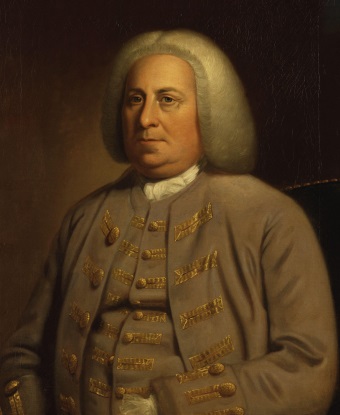Last updated: July 29, 2020
Person
Robert Dinwiddie

National Portrait Gallery
Following in the footsteps of his father, Robert Dinwiddie began his adult life as a merchant. Through this profession, he accumulated comfortable wealth, which smoothed his transition into politics.
Dinwiddie rose to the position of Lieutenant Governor of the colony of Virginia in July of 1751, serving in that capacity until January of 1758. Because of the absentee status of the governor, Dinwiddie was the de facto governor in his stead.
Dinwiddie was firm in his resolution to protect and expand the British presence in the Ohio River Valley. Part of this resolve came from the fact that he was a partner in the Ohio Company, a private company with vested interest in acquiring land in the west.
It was the Ohio Company that served to connect Dinwiddie with George Washington, as Washington had two brothers who were also members of the company. Dinwiddie recognized Washington's potential and would become his first mentor. In 1753 Dinwiddie sent Washington on a mission to deliver a letter to the French, in which he demanded the French leave the Ohio River Valley. Washington met with the French at Fort LeBoeuf, where the commander, not surprisingly, politely but firmly refused to leave. He wrote a response to Dinwiddie saying, “As to the summons you send me to retire, I do not think myself obliged to obey it.” Washington hurried to deliver the French response to Dinwiddie.
Dinwiddie placed Washington in a position of leadership again in 1754, sending him west as lieutenant colonel of the Virginia Regiment, leading over 160 Virginia soldiers. Dinwiddie instructed Washington, “You are to use all Expedition in proceeding to the Fork of Ohio, with the Men under Yr Comd & there You are to finish & compleat in the best Manner, & as soon as You possibly can the Fort which I expect is there already begun by the Ohio Compa.” The fort that Dinwiddie was referencing was Fort Trent, at the Forks of the Ohio (Pittsburgh, PA). Washington and his men departed. Washington soon learned that the French had expelled the British from Fort Trent and established their own fort, Fort Duquesne.
In these altered circumstances, Washington’s confrontation with the French arrived soon enough. He engaged with the French in a bloody skirmish at Jumonville Glen in May of 1754, and at the Battle of Fort Necessity in July of 1754. Washington’s mistakes and failures on this campaign would require further action on behalf of the British administration to secure land in the west.
Dinwiddie left Virginia in 1758 and returned to England, where he died in 1770. However, it was his actions in colonial Virginia that were influential in the start of the French and Indian War. His strident defense of the colony helped increase the tensions between the French and British in North America. He was not opposed to using force to protect Virginia's territorial claims. It was while he was governor of the colony that the first shots were fired, in a skirmish involving his protégé George Washington.
Author: Catarina Hurtado
Sources:
https://en.wikipedia.org/wiki/Robert_Dinwiddie
Zimmerman, John H. “Robert Dinwiddie.” George Washington’s Mount Vernon. Accessed June 10, 2020. https://www.mountvernon.org/library/digitalhistory/digital-encyclopedia/article/robert-dinwiddie/.
https://www.findagrave.com/memorial/101966529/robert-dinwiddie
“To George Washington from Robert Dinwiddie, January 1754.” Founders Online. National Archives. https://founders.archives.gov/documents/Washington/02-01-02-0031. [Original source: The Papers of George Washington, Colonial Series, vol. 1, 7 July 1748 – 14 August 1755, ed. W. W. Abbot. Charlottesville: University Press of Virginia, 1983, pp. 63–67.]
https://www.nps.gov/fone/prelude.htm
